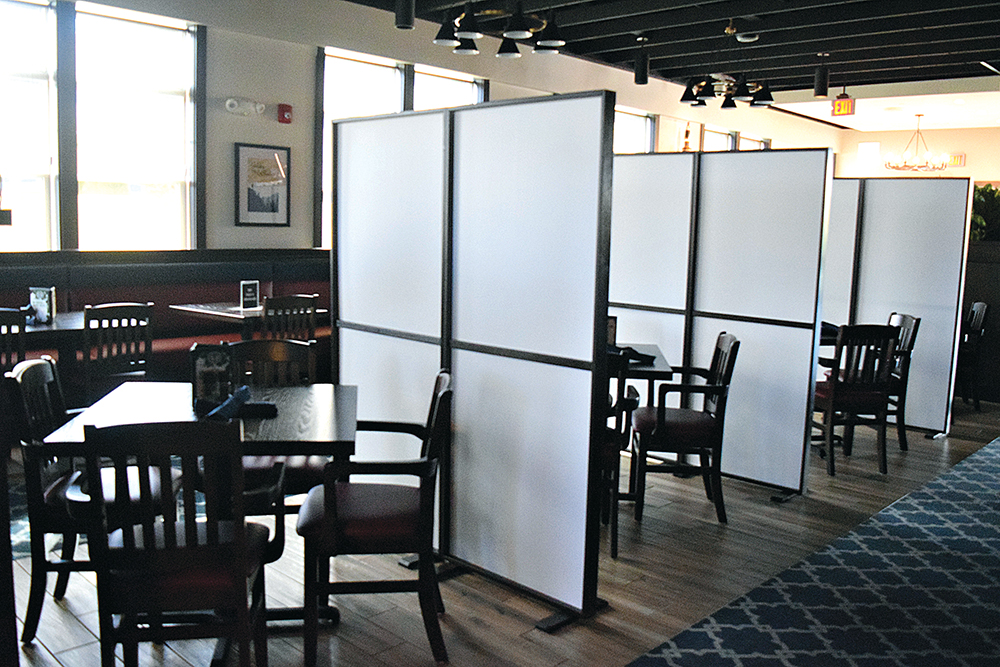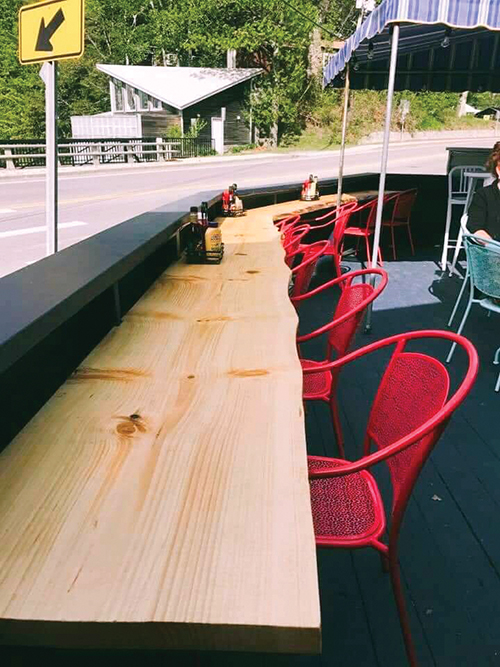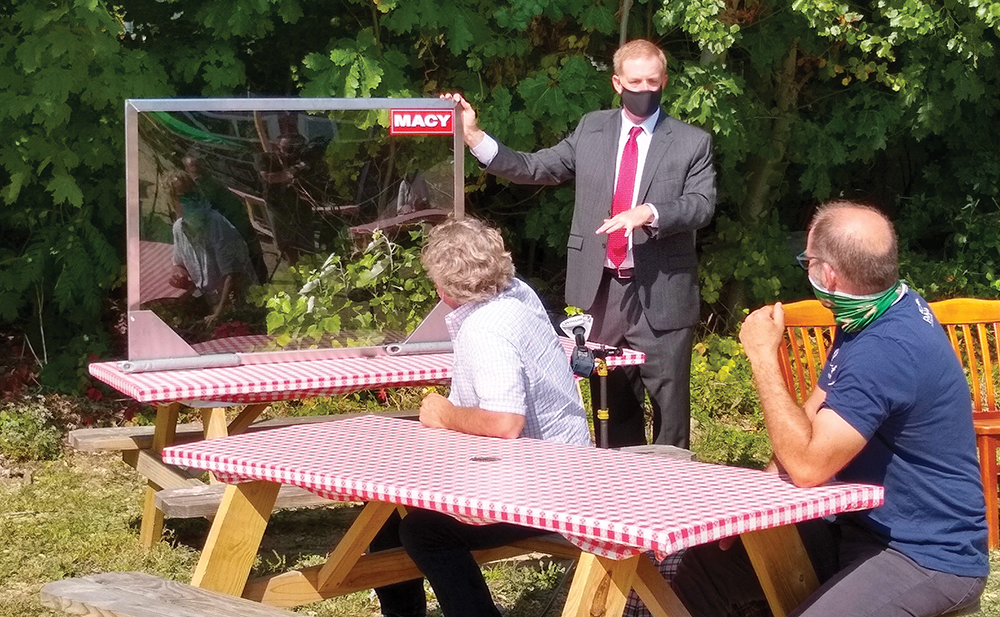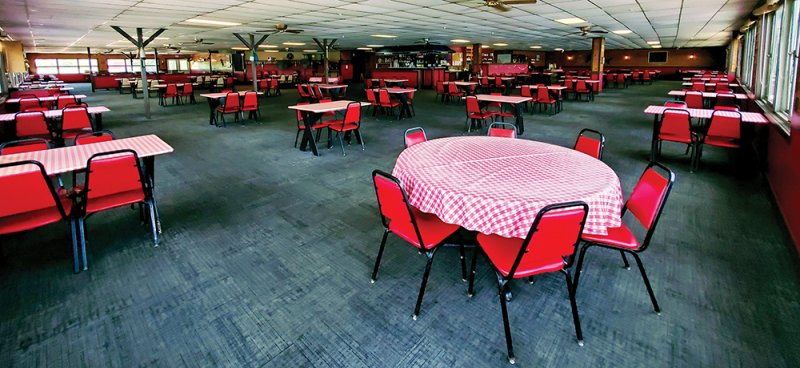 Indoor seating with barriers at T-BONES in Concord. Courtesy photo.
Indoor seating with barriers at T-BONES in Concord. Courtesy photo.
Revenue is down, expenses are up, and with layers of federal, state and local regulations driven by the pandemic, restaurants face a long, cold winter.
New Hampshire Lodging and Restaurant Association President and CEO Mike Somers says he doesn’t have hard statistics but estimates that more than 200 NH restaurants have gone out of business since the beginning of the COVID-19 pandemic.
State mandates abruptly closed restaurants in March and gradually reopened them through the summer under a variety of restrictions that left them well below capacity. To survive, restaurants experimented with takeout options, social media campaigns and online ordering. A saving grace for some was creating outdoor seating. But as tents come down and picnic tables are stowed, restaurants must maximize indoor options and overcome the biggest challenge: making customers feel safe.
“According to the National Restaurant Association, 100,000 restaurants have closed in this country since March. That’s one in six,” says Tom Boucher, owner and CEO of Bedford-based Great NH Restaurants, which employs almost 1,000 people and includes T-BONES, CJ’s, Cactus Jack’s and Copper Door.
The National Restaurant Association estimates the industry will lose $240 billion by the end of the year. Boucher says he expects the closures will be worse in colder climates such as NH’s.
“I am [very concerned about] this winter, and we are one of the most successful restaurant groups in the state,” says Boucher. “I have a team of incredible leaders around me that I can lean on. I can’t imagine being a single restaurateur trying to navigate all of this. I just want the public to understand and, more importantly, I want Congress to understand how desperate we are coming into these winter months.”
When NH Gov. Chris Sununu issued the initial stay at home order in March, it was one of the strictest in the country, limiting restaurants to carry-out, delivery, curbside pick-up and drive through. When indoor spaces were reopened in May, it was only at 50% capacity. Sununu says he shut the restaurants down abruptly in March because he recognized that with Massachusetts shutting down its restaurants and bars just days before St. Patrick’s Day, NH would have a huge influx of people from the Boston area.
 And while there have been new safety protocols put in place to allow restaurants to increase capacity, dining out is often connected to attending a concert, an event or recreation activity, and those have either been curtailed or canceled. Bob (Bubba) Williams, owner of Bubba’s Bar & Grille in Newbury (outdoor seating pictured), says it is impossible to predict what winter will bring. “We’re about a mile-and-a-half from Mount Sunapee, and we are not sure what they are doing. They may be operating at 25% capacity, reservations only, no food, no booze, we just don’t know,” he says. “One of the hardest parts of this pandemic is that there’s no playbook; we are writing it as we go.”
And while there have been new safety protocols put in place to allow restaurants to increase capacity, dining out is often connected to attending a concert, an event or recreation activity, and those have either been curtailed or canceled. Bob (Bubba) Williams, owner of Bubba’s Bar & Grille in Newbury (outdoor seating pictured), says it is impossible to predict what winter will bring. “We’re about a mile-and-a-half from Mount Sunapee, and we are not sure what they are doing. They may be operating at 25% capacity, reservations only, no food, no booze, we just don’t know,” he says. “One of the hardest parts of this pandemic is that there’s no playbook; we are writing it as we go.”
For Brian Shea, owner of The Barley House Restaurant and Tavern in Concord and North Hampton, known for its Irish music on Tuesday nights, loss of entertainment hurts the after-dinner crowd and the time between lunch and dinner.
Policing social distancing between patrons is difficult. Newick’s Lobster House in Dover and Concord returned to offering mercy meals in conjunction with funerals, allowing groups of six at each table with the requirement that they need to stay seated. “But they tend to want to get up and cluster, and anytime that happens staff have to address it,” says Owner Steve Newick. “If they got three strikes, that’s it. We have escorted parties out. You have to be on top of it.”
The biggest unknown and perhaps the biggest fear for restaurant owners is how comfortable people are with going out to eat this winter. Sununu says that in the states where there were big spikes, consumer confidence has not returned. And COVID-19 cases are rising again. “I think it’s not going to be back to normal on January first.... I think it will be next spring before we get back to normal. Even when a vaccine is approved, it will take months to deploy,” he says.
Boucher says restaurant owners should be working with their landlords on a strategy to make it through the winter. “Our landlord gave us a reduced rent for the next four months and will allow us to pay it back, starting next spring, over 12 months,” he says. Boucher says their health insurance company also provided some relief.
Outdoor Seating
During the summer, many restaurants found ways to create or expand outdoor seating, but it was always going to be a short-term fix. Newick says the only good thing about the drought this summer is the boost it gave to outside dining. Shea agrees the weather was a blessing. “We were really lucky this year. We’ve gone through summers where the whole month of June it just poured rain,” he says.
Jay Bolduc, managing operator for Great NH Restaurants, says outside dining was crucial. “We were able to add up to 200 seats at some of our locations. It ended up representing roughly 35% of our sales for the summer season when it is usually less than 10%,” he says.
Jay McSharry, who owns Jumpin’ Jays Fish Cafe, Moxy, and Vida Cantina in Portsmouth, as well as three Dos Amigos locations, says he is grateful to the cities that provided extra space for outdoor seating. The city of Portsmouth closed down one of the lanes on Congress Street, which allowed McSharry to put 20 seats outside and run at 50% capacity inside.
The experience was slightly different for Evan Mallett, owner of The Black Trumpet in Portsmouth, who says he asked for outdoor seating early on but was one of the last restaurants to get it. He was finally able to augment it with 12 seats outside in the last week in July. “It’s [the outdoor seating] charming and beautiful, it looks like Paris and people love it, but it’s nowhere near enough of what we would typically expect to bring in at this time of the year,” he says.
At the Revolution Taproom in Rochester, owner Stacey Marchionni says she too had a decent summer. “We’ve always had outdoor seating, which we lease from the city, which holds 72 without social distance. The city allowed us to expand it adding space from the parking lot, getting us to 60.”

Outdoor seating at Revolution Taproom in Rochester. Courtesy photo.
The Common Man family of restaurants, which includes 15 restaurants, diners and cafes, already had some outdoor seating, says COO Sean Brown. “We are fortunate to have an internal construction team, so we put them to work quickly making about 100 outdoor picnic tables,” he says.
If You Build it, Will They Come?
When the 50% restriction was lifted in September, restaurants still needed to maintain the 6-foot distance between tables and booths. The state threw owners a lifeline at the summer’s end allowing closer seating if parties were separated by a partition. Prior to approval of barriers or partitions, Common Man was already working on those logistics, developing prototypes that their construction team built to be ready as soon as approval came.
“I think we’ve done a really good job of demonstrating that we’re committed to keeping people safe and keeping proper distances. Once people come inside and they dine with us they feel pretty safe at the end of their experience and are pretty happy to come back,” says Brown.
Somers called the decision to allow barriers to increase indoor seating in September welcome news at just the right time as restaurants across the state were wrestling with how to survive the winter when outdoor dining was no longer an option.
At a recent industry gathering, Somers brought an example of a barrier that can go atop the back of a booth or banquette, manufactured by Macy Industries in Hooksett. Barriers must be 6 feet high from the floor to the top and made of a rigid and non-porous material. He says there are plenty of options that meet the standard, and the Restaurant Association would be gathering information to provide to members.
Macy Industries CEO Nick Mercier says he reached out to the governor’s office with the offer to manufacture the barriers for the industry at cost. He has since started receiving orders for separators and Lexan panels.

NHLRA President and CEO Mike Somers displays a barrier, created by Macy Industries, that can be used atop a booth or banquet. Photo by Judi Currie.
Bolduc says most Great NH locations are in counties that were restricted to 50% capacity, and even when those counties
went back to 100%, they didn’t see an immediate jump in indoor diners, but they do expect that to increase now with the use of barriers.
For George and Carol Lawrence, the barriers will allow them to increase booth seating from six to 11 parties at their original Red Arrow Diner in Manchester, the smallest of their locations that include Londonderry, Concord and Nashua.
George Lawrence says it is paramount to make customers feel safe, otherwise “it’s just not going to happen.”
Another iconic destination at the other end of the scale is Newick’s, which has seating for hundreds. “We have 300 seats inside, all socially distanced right now,” Newick says. “But most restaurants don’t have that luxury. We can have the seats we need but will people come out? Are they going to want to eat indoors?”

Socially distanced seating at Newick’s in Dover. Courtesy photo.
A possible stumbling block with partitions and divider walls, says Mallett of The Black Trumpet, is that municipalities are still allowed to make their own code decisions which could potentially remove or limit options and add to the cost.
Michael Prete, owner of The Kitchen Andover, Portsmouth Catering Co. and Hawthorne & Tappers, all based in Andover, says he has always stayed ahead of any mandates and mandated masks early on. “We put up plexiglass barriers and bought cleaning things before the stores and manufacturers ran out,” says Prete. “Our tables are still distanced and won’t go back until there is a vaccine and/or the cases drop significantly.”
Takeout Isn’t an Easy Answer
Shifting to takeout may sound as simple as ordering extra to-go containers, but the logistics are far more complex. When takeout was the only dining option, some of the state’s most well-established eateries didn’t have tools in place for online ordering or the capacity to handle the sudden surge.
Marchionni says she closed the Revolution Taproom for several weeks early in the pandemic. “Takeout just wasn’t a winning proposition for us,” she says. “It’s tough on scratch-kitchens. Our food doesn’t always travel that well; it’s best when it’s fresh, and people know that. We decided to add a wood-fired pizza oven as a way of hedging our bets against the winter by offering something a little more takeout friendly.”
Williams says takeout business at Bubba’s was almost too strong, taxing both front and back of house. With 30 to 40 calls an hour, staging the food required a significant investment in new shelving to hold dozens of orders. It also required re-tooling of the entire process, getting multiple eyes on the product before it leaves the building.
“The key with takeout is getting it right. If you put out one bad meal, they tell 10 people. At least if you’re in-house and they are there, you can fix your mistake. It was a logistical nightmare for a while,” says Williams.
He says if takeout drops to pre-pandemic levels, he will have too much capacity. “We built the church for Easter Sunday and it may only come once a year, but we had to do it.”
To help meet demand for takeout, Bolduc says Great NH Restaurants repurposed a kitchen specifically to prepare meals for delivery only.
They created DingDongDeliver.com as an ordering platform, and Boucher says they are also experimenting with Uber Eats at some locations.
COVID Closures
Despite concerted efforts to keep staff and customers safe, restaurateurs are beginning to shut down again due to COVID.
Four Portsmouth restaurants closed in a matter of days at the beginning of October due to COVID-19 exposure among staff. Jumpin’ Jay’s Fish Cafe voluntarily closed on Oct. 7 and was expected to reopen Oct. 20.
“Please know that we have met or exceeded state and CDC guidelines in our quick and independent decision to close, test and quarantine, as the safety of our staff and guests is our top priority,” a statement reads. “Our facility has been professionally cleaned, and we will not reopen until it is safe and prudent to do so.”
The following day, the Flatbread Company reported that one of its employees at its Portsmouth location had also tested positive. “After being notified of the situation, we made the quick decision to not only close out of an abundance of caution but also assist all of our team members to get tested,” a statement reads.
On Oct. 11, two other Portsmouth restaurants, The Rosa and Martingale Wharf, temporarily closed after a member of The Rosa’s staff tested positive for COVID-19. “There have been zero positive tests for employees at Martingale Wharf,” a statement reads. “We decided to close Martingale Wharf with The Rosa temporarily to have them both professionally cleaned and sanitized at the same time for extra precaution.”
One of the earliest restaurants with potential community exposure, according to state data, was the Tuckaway Tavern and Butchery in Raymond. People who visited the weekend of July 24-26 and sat at the bar may have been exposed to COVID-19.
Sununu says working with Dr. Benjamin P. Chan, the state epidemiologist, has reached out to states with outbreaks and learned bars were particularly risky; including an incident where 100 cases of COVID-19 were attributed to a single bar.
“Nobody wants to be the source of an outbreak,” Sununu says. “That’s going to end your business a lot faster than any barrier is, unfortunately. No one wants to have that on them. I think the restaurant owners in the state have done a terrific job of stepping up; you’ve got to survive. Unfortunately, 2020 is turning into a year of surviving, not a year of thriving.”
Community Matters
Despite the hardships created by the pandemic, the restaurant industry is stepping up to support the community. Many found ways to donate food that would have otherwise been lost when the shutdown occurred and have continued to support local organizations. Several paid extra wages to staff and many fed frontline workers in hospitals and emergency services.
Great NH Restaurants, with the help of additional food and beverage companies, raised nearly $80,000 for its charitable trust FEEDNH.org with its annual golf tournament.
Prete says he sold (at near cost) meats, flour, fish, beans, toilet paper, pastas and bread to customers when the stores were empty. He and his staff hid Easter eggs around town with gift cards in them. “We gave out thousands of dollars in gift cards to people that needed it and let people run tabs,” he says.


Left: Alex Ray, owner of The Common Man, puts up a “Do Good, Every Day” sign. Right: The restaurant donated home-cooked meals to The Friendly Kitchen soup kitchen in Concord.Courtesy photo.
The Common Man has continued to donate gift cards and prizes to nonprofit fundraisers that went virtual, provided furloughed staff with a daily family meal until they were hired back and launched a new “Do Good” initiative, “Feed it Forward,” which invited takeout guests to make a donation that was allocated to feeding those in need.
“During such a difficult time, we wanted to spread positivity and kindness,” says Erica Auciello Murphy, director of communications and community relations for The Common Man Family of Restaurants.
